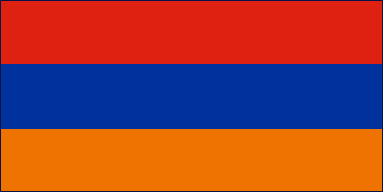
About Flag of Armenia
Three horizontal bands of equal width make up the Armenian flag: the top stripe is red, the middle stripe is blue, and the bottom stripe is orange. The Armenian flag’s colours stand in for its population.
The flag’s crimson colour symbolises the blood and sacrifice of Armenian troops who have died in several conflicts throughout history and the present. Orange represents Armenia’s productive regions, and blue symbolises optimism and desire for the country’s advancement.
Historical Background
The current design of the Armenian flag dates back to the early 20th century when Armenia gained independence from the Russian Empire in 1918. However, variations of the tricolor design have been used throughout Armenian history.
Facts about Armenia flag |
| Country | Armenia |
|---|---|
| Designed by | Stepan Malkhasyants |
| Adopted | 24. August 1990 |
| Revision | NA |
| Design and Colors | A horizontal tricolour of red, blue, and orange |
| Size Ratio | 1:2 |
| Official Name: | The Republic of Armenia |
| Proportion: | 1:2 |
| Adopted on: | August 24, 1990 |
| Designed by: | The independent Armenian government |
| Location: | At the crossroads of Western Asia and Eastern Europe |
| Capital City: | Yerevan |
| Major Cities: | Sevan, Stepanavan, Aragatsotn, Ararat |
| Area: | 11,484 square miles |
| Population: | 3,262,200 |
| Currency: | Dram |
| Official Language: | Armenian |
| National Anthem: | Our Fatherland |
| National symbol(s): | Mount Ararat, eagle, lion |
| National colors: | red, blue, orange |
| National anthem: | |
| Name: | “Mer Hayrenik” (Our Fatherland) |
| Lyrics/music: | Mikael NALBANDIAN/Barsegh KANACHYAN |
Design and Colors
The Armenian flag consists of three horizontal stripes of equal width. The top stripe is red, the middle stripe is blue, and the bottom stripe is orange. These vibrant colors create a visually striking combination that instantly captures attention.
Symbolism of the Armenia Flag
Each color on the Armenian flag carries significant symbolism. The red stripe represents the sacrifice and struggle of the Armenian people throughout history. It serves as a reminder of the Armenian Genocide and the bloodshed endured by the nation. The blue stripe symbolizes the Armenian people’s determination to build a peaceful and bright future. The orange stripe represents the courage and resilience of the Armenian people in the face of challenges.
Usage and Protocol
The Armenian flag is proudly displayed throughout the country on government buildings, schools, and private residences. It is raised during national holidays, official ceremonies, and sporting events to express unity and national pride. When handling the flag, it is important to treat it with respect and dignity.
FAQs
Q1: When did Armenia gain independence?
Armenia gained independence from the Russian Empire in 1918.
Q2: What do the colors on the Armenian flag represent?
The red stripe represents sacrifice and struggle, the blue stripe symbolizes determination, and the orange stripe represents courage and resilience.
Q3: Is there any historical significance to the Armenian flag design?
The tricolor design has been used throughout Armenian history, and the current design dates back to the early 20th century.
Q4: When is the Armenian flag raised?
The Armenian flag is raised during national holidays, official ceremonies, and sporting events to express unity and national pride.
Q5: How should the Armenian flag be handled?
The Armenian flag should be treated with respect and dignity when handling it.

